Social media is no longer just a space for casual updates or entertainment—it has become a highly effective platform for brand building, customer engagement, and increased website traffic. With billions of active users across social networks – Facebook, Instagram, TikTok, LinkedIn, and X (formerly Twitter) – optimizing social media profiles and content is crucial for brands aiming to stand out in a crowded digital landscape.
- What is Social Media Optimization (SMO)?
- SMO vs. SMM—Understanding the Difference
- The 5 Pillars of Social Media Optimization
- Best Practices for Effective SMO in 2025
- Essential Tools to Make SMO Easier
- Conclusion
- DMP—Your Partner in Social Media Success
What is Social Media Optimization (SMO)?
Social Media Optimization (SMO) is the strategic process of refining social media profiles, content, and engagement tactics to maximize a brand’s visibility, appeal, and interaction organically. Proper optimization helps you connect with your audience more effectively, turning casual visitors into loyal followers and customers.
SMO vs. SMM—Understanding the Difference
It is important to distinguish Social Media Optimization (SMO) from Social Media Marketing (SMM) as both play complementary yet distinct roles in digital strategy.
- Social Media Marketing (SMM) involves creating and distributing content, including paid advertisements and campaigns designed to attract and engage audiences quickly.
- Social Media Optimization (SMO) focuses on enhancing content and profiles organically — fine-tuning your social media presence so marketing efforts consistently reach the right audience at the right time, maximizing impact without direct ad spend.
Understanding their differences can help you leverage both strategies effectively:
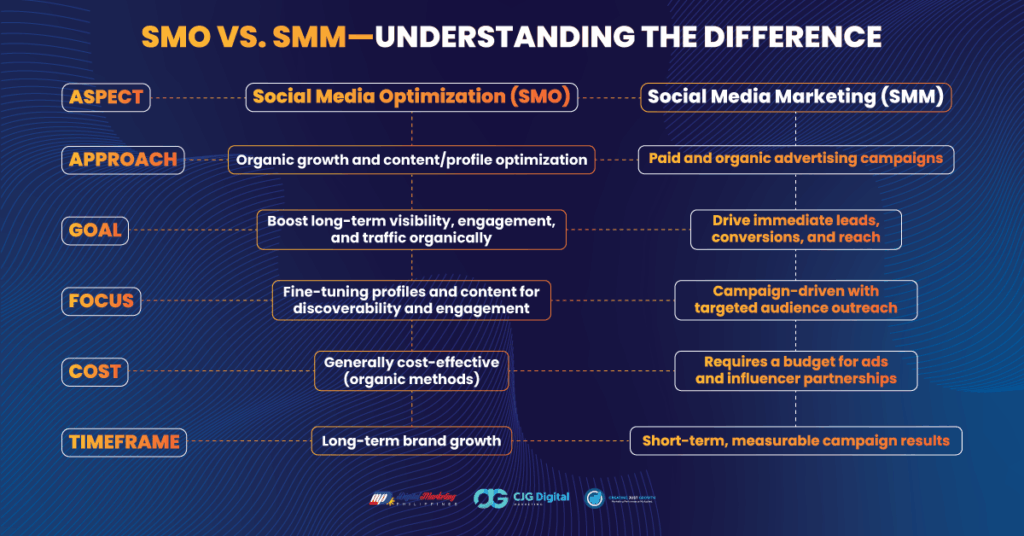
The 5 Pillars of Social Media Optimization
Effective SMO is built on a foundation of five core components that collectively enhance a brand’s social media impact:
1. Profile Optimization
Your social media profile is your brand’s digital storefront—it must be immediately recognizable, trustworthy, and actionable. Profile Optimization is about ensuring that every piece of static profile information is leveraged for maximum searchability and conversion.
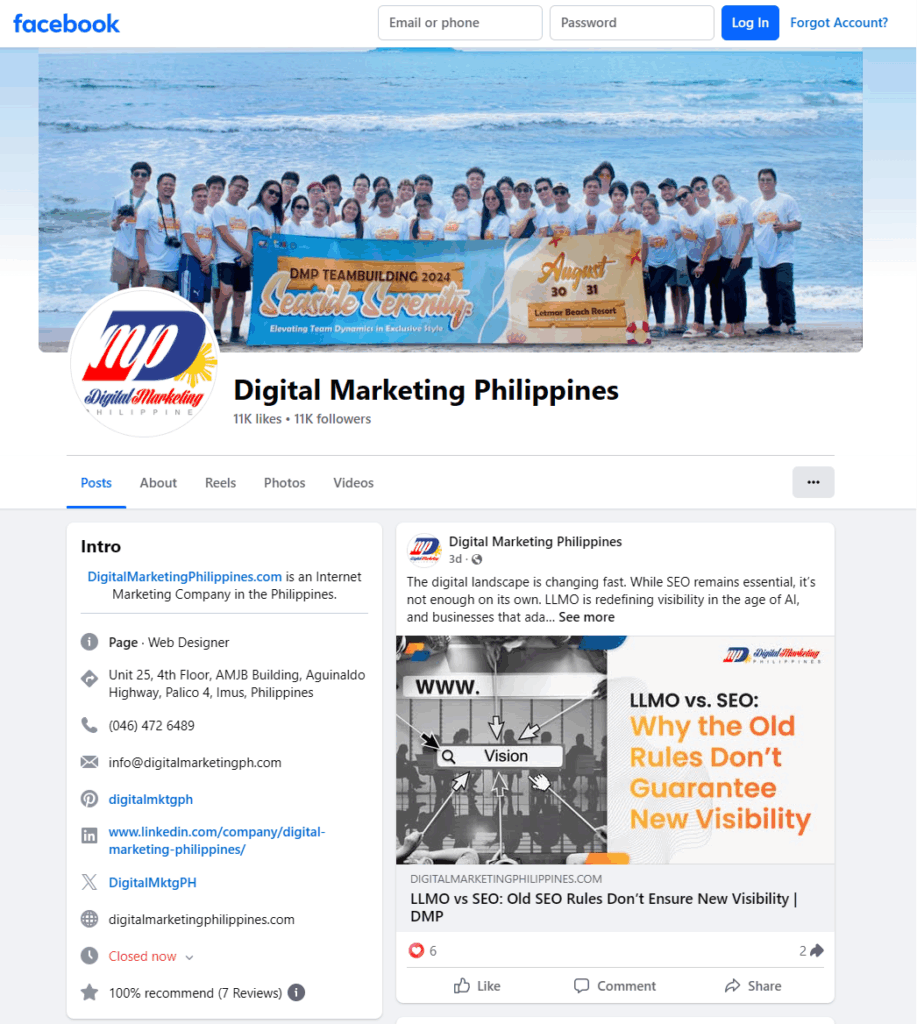
Checklist for Profile Optimization:
- Use a consistent username across platforms for easy brand discovery.
- Upload a high-quality, recognizable profile picture.
- Craft a compelling, keyword-rich bio explaining your offerings clearly.
- Include a trackable website link via tools like Bitly or UTM parameters.
- Add contact info and business categories to improve searchability.
- Utilize features like Instagram Highlights or Facebook pinned posts to showcase key info and testimonials.
2. Content Optimization
Content is the fuel for your social engine, but even the best ideas fail without optimization. Social media content optimization safeguards that your message reaches the largest relevant audience and achieves its intended goal—be it a click, a comment, or a share.
Key tactics include:
- Use varied formats—short videos, images, stories, reels, polls, and carousels—that perform best on each platform.
- Include hashtags and keywords strategically without stuffing.
- Mix evergreen and trending topics to keep content fresh and relevant.
- Keep captions short, engaging, and relevant, and with a clear call-to-action (CTA).
Content that educates, entertains, or solves a problem often generates higher engagement. Regular audits can also reveal what resonates most with your audience.
This image was taken from Sprout Social
3. Engagement Optimization
Posting on social media platforms is only half the equation—interaction fuels SMO. Algorithms prioritize content that generates early and meaningful interaction.
Engagement Optimization is the process of setting the stage for high-quality conversations and community building, not just accumulating passive likes. Effective engagement optimization best practices include:
- Respond quickly and professionally to comments and direct messages.
- Use interactive formats (e.g., Q&As, quizzes, polls, and live streams) to get your audience involved.
- Mention and tag relevant accounts, brands, or influencers to expand reach.
4. Growth Optimization
Growth Optimization is the deliberate, strategic approach to broadening your reach and increasing your follower count, focusing on quality over sheer quantity. A highly engaged audience of 10,000 is more valuable than a passive audience of 100,000.
While high-quality content is a prerequisite, strategic tactics are needed to accelerate growth. Such include:
- Optimizing scheduling by analyzing when your specific audience is most active and engaged.
- Cross-promoting social profiles on your website, email signatures, and other marketing materials.
- Leveraging micro-influencers for niche audience expansion.
- Engaging with communities relevant to your industry to attract followers.
- Encouraging followers to share your content to amplify reach.
5. Performance Optimization
Optimization does not stop after posting—you also need to understand data and track the performance of your social media content strategy for continuous improvement.
This image was taken from Buffer.
Performance optimization is the discipline of treating your social media strategy like a science experiment: testing, measuring, and refining. Without tracking and analysis, you are essentially operating in the dark.
Here are the best practices for performance optimization:
- Define KPIs.
Beyond vanity metrics like “likes,” define actionable key performance indicators (KPIs) that connect directly to business objectives. These include:
- Reach & Impressions – The total number of people who saw your content.
- Engagement Rate – The percentage of people who saw your content and interacted with it. Comments, shares, and saves are more valuable than likes.
- Conversion Rate – The percentage of clicks from social media that result in a desired action (e.g., sign-up, purchase, follow).
- A/B Testing.
Dedicate resources to consistently A/B test key variables: different content formats (static image vs. video), different CTA phrasing, different posting times, and even different headline structures. Use the data to isolate which factors drive superior performance.
- Analyze Audience Data.
Use native platform analytics to understand demographic shifts, peak activity times, and the content topics that resonate most. This data should inform your entire content calendar for the next optimization cycle. For instance:
- If your audience responds overwhelmingly to “how-to” guides, double down on that format.
- If your Reels perform better than your static posts, re-allocate creative resources accordingly.
Performance Optimization closes the loop and ensures your strategy is always data-driven.
Best Practices for Effective SMO in 2025
As the social media landscape evolves, so too must your optimization tactics. Success in SMO requires adherence to best practices for social media marketing and SMO basics for beginners to keep pace with platform algorithms and audience expectations.
- Set Clear Goals. Defining specific social media goals aligned with broader business objectives helps guide content creation and performance tracking. Whether aiming for brand awareness, website traffic, or lead generation, measurable objectives keep your content strategy focused and effective.
- Adapt to Algorithms. Working with social media platform algorithms means using relevant keywords, hashtags, and posting high-quality content consistently. This increases the chances of your content being recommended, shared, and saved by your audience.
- Focus on Key Platforms. Concentrate your efforts on 2-3 social media platforms where your audience is most active. Avoid spreading resources too thin across multiple channels, as this can weaken engagement and reduce the overall impact.
- Prioritize Interactive Content. Incorporate content formats that encourage user interaction, such as live videos, reels, polls, and quizzes. Interactive contents tend to drive higher engagement and foster a stronger connection with your audience.
- Monitor Competitors. Regularly monitor competitors’ social media tactics to gather insights and identify opportunities for improvement. Use what you have learned to refine your strategy without simply copying what others are doing.
- Balance Content Types. Balance your posting schedule with about 80% evergreen content and 20% topical posts. This mix ensures you maintain relevance while providing lasting value to your followers.
- Use Social Listening. Leverage social listening and monitoring tools to track brand mentions and trending conversations. Engaging authentically in these discussions helps build community trust and expand your reach.
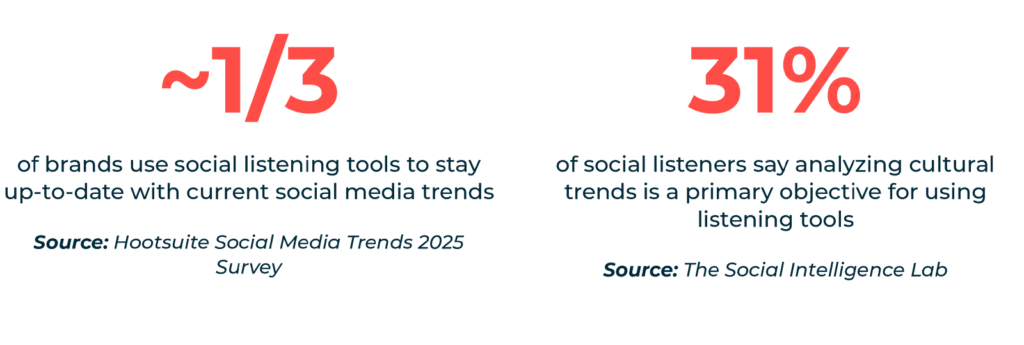
This image was taken from Hootsuite.
Common Mistakes to Avoid in SMO
While SMO offers incredible potential, it is easy to make mistakes that may hinder your progress. Avoiding these pitfalls can save time and help make sure your efforts are not wasted:
- Overusing or using irrelevant hashtags.
A good hashtag strategy is not about quantity but quality. Using too many or unrelated hashtags can make your content look spammy and turn off potential followers.
- Posting inconsistently.
Consistency is a non-negotiable part of SMO. Inconsistent posting can cause a drop in engagement and a loss of followers who may forget about your brand. A regular posting schedule keeps your brand top-of-mind.
- Ignoring analytics and feedback.
Your analytics are a direct line of communication from your audience. Ignoring them means you are missing crucial insights into what works and what does not. Likewise, overlooking comments and feedback, both positive and negative, makes your brand seem unapproachable.
- Over-automation.
While scheduling tools are essential, relying too heavily on automation can make your brand’s presence feel robotic. Remember to engage with your community in real-time and show genuine personality to maintain authentic connections.
Essential Tools to Make SMO Easier
Effective optimization can be time-consuming, but the right suite of digital tools can automate repetitive tasks, provide essential data, and streamline your workflow.
- Scheduling and Publishing Platforms
Tools like Sprout Social, Hootsuite, or Buffer allow you to plan, schedule, and review content across multiple platforms from a single dashboard. This ensures posting consistency, a fundamental pillar of optimization.
- Analytics and Reporting Tools
Social Insider, Google Analytics (for tracking referral traffic), and native platform analytics offer the necessary data for your Performance Optimization pillar. They provide deep insights into when and what to optimize to maximize engagement.
- Social Media Listening Tools
Sprout Social, Mentionlytics, and Hootsuite Insights, among other social listening tools, help track brand mentions, sentiments, and conversations across social networks and the wider web. They enable you to stay informed of online discussions, respond in a timely manner, and adapt strategies based on real-time data.
- Design and Asset Creation
Tools like Canva and Adobe Express empower teams without dedicated design resources to quickly create optimized, correctly-sized, and visually engaging content that meets the specifications of each unique platform.
Using these tools helps you manage posting calendars, maintain branding, create engaging content, and analyze performance efficiently.
Conclusion
Social Media Optimization is a strategic, data-driven approach to building an engaging online presence that supports your broader digital marketing goals. Success requires consistent optimization of profiles, content, and engagement, combined with continuous analysis and adaptation to social media trends in 2025.
When you invest in these incremental, ongoing efforts, you will enjoy stronger organic growth and a loyal, engaged audience. If the complexity of scaling optimization across multiple platforms feels overwhelming, know that expert help is available. You can hire an SEO expert Philippines knowledgeable in optimizing digital marketing strategies for search engines, but also social media platforms.
DMP—Your Partner in Social Media Success
For expert support in crafting a tailored Social Media Optimization (SMO) strategy that fits your business goals, contact Digital Marketing Philippines (DMP).
At DMP, we offer comprehensive outsourced social media services alongside affordable SEO services for small business Philippines. Our expertise can help you achieve goals such as:
- Brand exposure and awareness
- Reputation management
- Remarketing campaigns
- Audience building and engagement
When you partner with us, our seasoned social media experts start by thoroughly assessing your current social presence across platforms to identify the highest-impact opportunities. From there, we guide you through proven strategies tailored to expand and enhance your online presence, helping you reach your desired level of brand visibility and interaction.
Contact DMP today to partner with experts and boost your social media game.
References
https://www.shopify.com/ph/blog/social-media-optimization
https://digitalmarketinginstitute.com/blog/a-best-practice-guide-to-social-media-marketing
https://techiegigs.com/beginners-guide-to-social-media-optimization/
https://postoplan.contenive.com/blog/social-media-optimization-tips-tools-examples-amp-checklist
https://www.youngurbanproject.com/what-is-social-media-optimization
https://www.socialinsider.io/blog/social-media-optimization
https://www.digitale.co.in/journals/5-crucial-differences-between-smo-smm
https://www.nascenture.com/blog/differences-between-smo-and-smm
https://www.itrobes.com/difference-between-smo-and-smm
Jomer B. Gregorio is a well-rounded expert when it comes digital marketing. Jomer is also known as a semantic SEO evangelist and practitioner. Check out our Digital Marketing Services today and let us help you in achieving positive and profitable results for your business.
